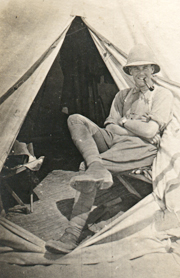I went up to the O.Pip at two thirty this morning to give the Ayrshire observing officer any help he could have wanted with regard to the zone. I was up there till five but there was no attack. At six o'clock we had 35 camels, struck our camp, and sent it onto Romani and followed on with the guns; we've come into action in the open here, behind the first line redoubts. They sent up three more battalions from the 42nd Division tonight.
From our reconnaissance today the old Turk at last means serious business. One of the Anzac patrols went out to Ogratina this morning but found it held by an advance guard of two hundred Turks who drove them back, though luckily with only a few casualties. This afternoon an Anzac patrol to Katia captured a patrol of these Turks.
Our last aeroplane to reconnoitre tonight has come in with the news that the Turks have now got eight thousand men and six guns at Ogratina (12 miles away) and are digging themselves in there. Their main body is at Bin el Abd.
Divisional headquarters have warned us that the attack is very imminent, and will in all possibility be tonight. If the chance offers, we are to go out on mobile column, but otherwise shall fire from our positions here.
We've got about ten thousand men in all here, including the Anzacs and the 157th Brigade at Mahamdiya so ought to be able to hold them; but the worst of it is they attack at night always and not by day.
One of our gravest problems here is the native labour corps. There are about eight thousand of them, and three time during this evening they have tried to break through the front line. They know what's on just as well as we do, and there is no shadow of doubt that half of them are in the pay of the Turks, but the infantry have now rounded them all up and marshalled them back about three miles down the line.
It is very much a case of sleeping with one eye open tonight.



On 20th, news came to hand that 8,000 Turks were advancing, and had reached Bir-el-Abd, 18 miles from Romani. The camp was struck and the Battery moved to Romani, all transport being carried out by camels - 32 in number. The guns and wagons were pulled by 10 horses, and there was one spare pair for each team. On arrival at Romani, orders were received for the guns to go into action on a dry marsh close to the railway on the South side, about half-a-mile west of railhead, With Hill 100 for their original line. The camp was pitched in the evening on the top edge of the sandhill, overlooking the marsh, on its southern side, with the wagon lines close up under the sandhill.
It was reported that eight to fifteen thousand Turks had reached Ogratina (twelve miles distant). Lieutenant Badcock and two signallers slept at the forward observing station on Hill 46, one-and-a-half miles N.E. by E. of the gun position, close behind Fort 8.
Troop trains were arriving all day, and the force at Romani was gradually doubled, reaching the number of 8,000 odd. The Australians were in touch with the Turks, and held them in check as they retired, and captured a few men. At night it was reported that the Australians were in touch with the Turkish patrols close to Katia (6 miles away). The Battery had orders to establish a mobile column ready to move out at any moment.
The other batteries at Romani were the West Riding, the Ayrshire R.H.A., and the Howitzer (263rd) Brigade. A patrol of infantry was told off to protect the Battery from surprise, from the southern and exposed flank.
The horses remained where they had been all the time-about N.W. of Katib Ganit, the highest hill in the neighbourhood (228ft.) were half-a-mile distant from the camp.
All guns were ready to open fire at any moment. There were 1,000 rounds in possession of the Battery. The camp was considered to be one of the best in the desert, as there were light breezes straight from the sea, even in the early morning. The only disadvantage was that a strong wind, such as blew nearly every afternoon at a later date, was apt to blow the sand from under the tent valences and smother the tent.